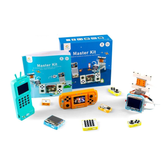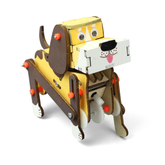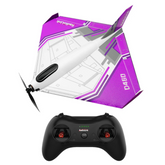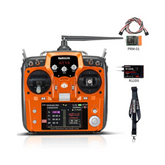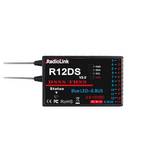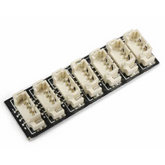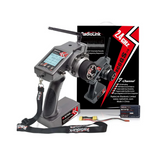-
Radiolink R8FM 2.4GHz 8-Channel RC Receiver SBUS/PPM for Mini FPV Racing DronesRadiolink R8FM 2.4GHz 8-Channel RC Receiver SBUS/PPM for Mini FPV Racing Drones The Radiolink R8FM micro-RC receiver is a high-performance micro receiver designed for mini FPV racing drones, quadcopters, and aircraft. Equipped with a frequency hopping spread spectrum (FHSS) pseudo-random algorithm, it delivers excellent...
- Rs. 1,233
Rs. 1,999- Rs. 1,233
- Unit price
- per
Save Rs. 766 -
3.7v 716 Magnetic Micro Coreless CCW Motor for Drone Quadcopter3.7v 716 Magnetic Micro Coreless CCW Motor for Drone Quadcopter The 716 Magnetic Micro Coreless Motor for RC Drone Quadcopters is a very compact and lightweight DC motor nicely crafted for perfectly matching with your small 100mm like multirotor frames. The 7x16mm CCW lightweight brushed DC...
- Rs. 280
Rs. 493- Rs. 280
- Unit price
- per
Save Rs. 213 -
Radiolink R6DSM Mini Drone Receiver 2.4Ghz 10 Channels For Racing Drones, Quadcopter AircraftsRadiolink R6DSM Mini Drone Receiver 2.4Ghz 10 Channels for Racing Drones, Quadcopter Aircrafts The Radiolink R6DSM is a high-performance mini drone receiver designed for mini FPV racing drones, quadcopters, and small aircraft. This compact micro RC receiver supports 2.4GHz signal transmission and offers 10...
- Rs. 1,479
Rs. 1,999- Rs. 1,479
- Unit price
- per
Save Rs. 520 -
Radiolink R9DS RC Receiver 10 Channels 2.4GHz RC Receiver For Drones, Airplane, CarRadiolink R9DS RC Receiver 10 Channels 2.4GHz RC Receiver For Drones, Airplane, Car The powerful and reliable RC Receiver, Radiolink R9DS. Whether you are flying an airplane, driving an RC car, or piloting a multirotor, this receiver makes controlling your devices easier and more...
- Rs. 1,920
Rs. 2,499- Rs. 1,920
- Unit price
- per
Save Rs. 579 -
Radiolink R6DS 6/10 Channels RC Receiver 2.4GHzRadiolink R6DS 6/10 Channels RC Receiver 2.4GHz The Radiolink R6DS 2.4GHz RC Receiver is a reliable and compact solution for drone and fixed-wing airplane pilots. This high-performance 2.4 GHz RC Receiver supports up to 6/10 Channels RC Receiver modes using SBUS, PWM, or PPM,...
- Rs. 1,519
Rs. 1,999- Rs. 1,519
- Unit price
- per
Save Rs. 480 -
Radiolink D460 RC Airplane RTF – Byme-DB Gyro, Brushless, T8S TransmitterRadiolink D460 RC Airplane RTF – Byme-DB Gyro, Brushless, T8S Transmitter The Radiolink D460 is a fully assembled RC Airplane toy, ready to fly with magnet-secured parts that stay firmly in place during flight. Powered by the Byme-DB Gyro Flight Controller, it offers three...
- Rs. 16,799
Rs. 19,999- Rs. 16,799
- Unit price
- per
Save Rs. 3,200 -
Radiolink R6F 2.4 GHz, 6 Channel RC Receiver Long Range up to 400 mRadiolink R6F 2.4 GHz, 6 Channel RC Receiver The Radiolink R6F 6-Channel RC Receiver offers stable, long-range performance, delivering up to 400 meters (1300 feet) of control distance, making it perfect for RC cars, boats, and other models. As a reliable 2.4 GHz RC...
- Rs. 1,249
Rs. 1,869- Rs. 1,249
- Unit price
- per
Save Rs. 620 -
Radiolink AT10II with R12DS – Transmitter and Receiver for Drones, Cars & BoatsRadiolink AT10II with R12DS – Transmitter and Receiver for Drones, Cars & Boats The Radiolink AT10II Transmitter with R12DS 12-Channel Receiver is a high-performance receiver and transmitter for drone applications, as well as helicopters, airplanes, cars, and boats. Designed for precision and reliability, it...
- Rs. 13,499
Rs. 19,999- Rs. 13,499
- Unit price
- per
Save Rs. 6,500 -
Radiolink R12DS RC Receiver 2.4GHz 12 ChannelsRadiolink R12DS RC Receiver 2.4GHz 12 Channels The Radiolink R12DS 2.4GHz 12-Channel RC Receiver delivers long-range, stable control with a maximum distance of up to 2.4 miles (4km). Featuring DSSS & FHSS dual spread spectrum protocols, it offers excellent anti-interference performance, ensuring reliable signal...
- Rs. 2,399
Rs. 2,999- Rs. 2,399
- Unit price
- per
Save Rs. 600 -
Radiolink R12DSE 12-Channel Receiver with Dual Antennas with 4000m Range SBUS/PPMRadiolink R12DSE 12-Channel Receiver with Dual Antennas The Radiolink R12DSE 12-Channel Receiver offers up to 4000m control range with DSSS & FHSS hybrid spread spectrum for strong anti-interference and stable signals. Supporting 12 SBUS/PPM channels with a fast 3ms response, it’s ideal for racing...
- Rs. 1,994
Rs. 2,499- Rs. 1,994
- Unit price
- per
Save Rs. 505 -
Radiolink R4FGM 2.4GHz Long Range 4 Channel RC Receiver for RC Car with GyroRadiolink R4FGM 2.4GHz Long Range 4 Channel RC Receiver for RC Car with Gyro The Radiolink R4FGM DIY RC Receiver is engineered for precision, stability, and long-range performance. Featuring a pseudo-random FHSS algorithm, it delivers exceptional anti-interference capability with a control range of up...
- Rs. 1,519
Rs. 1,999- Rs. 1,519
- Unit price
- per
Save Rs. 480 -
Radiolink Byme-DB 4 Channel 3-Axis Flight Controller with Gyro Stabilizer for RC PlanesRadiolink Byme-DB 4 Channel 3-Axis Flight Controller with Gyro Stabilizer for RC Planes The Radiolink Byme-DB 4 Channel 3-Axis Flight Controller with Gyro Stabilizer brings stability and precision to RC flying. 3-axis gyro flight controller, it smooths out turbulence and ensures balanced control, making...
- Rs. 1,469
Rs. 1,999- Rs. 1,469
- Unit price
- per
Save Rs. 530 -
Radiolink A560 PNP RC Airplane with 6 Flight Modes (No Radio/Receiver/Charger)Radiolink A560 PNP RC Airplane with 6 Flight Modes The Radiolink A560 PNP RC Airplane is a versatile fixed-wing aircraft perfect for both beginners and experienced pilots. This Plug Play version comes without a charger, radio, or receiver, allowing you the freedom to use...
- Rs. 10,395
Rs. 14,299- Rs. 10,395
- Unit price
- per
Save Rs. 3,904 -
Radiolink 7P I2C Obstacle Avoidance Drone Expansion Board for PIXHAWK/Mini PixRadiolink 7P I2C Obstacle Avoidance Drone Expansion Board for PIXHAWK/Mini Pix The Radiolink 7P I2C Expansion Board is a high-performance obstacle avoidance drone expansion board designed to upgrade your drone’s navigation and safety features. It works seamlessly with the PIXHAWK Mini PIX Flight Controller...
- Rs. 549
Rs. 799- Rs. 549
- Unit price
- per
Save Rs. 250 -
Radiolink I2C Expansion Transfer Board for Flight Controllers with Dual I2C PortsRadiolink I2C Expansion Transfer Board for Flight Controllers with Dual I2C Ports The Radiolink I2C Expansion Board is a compact, yet powerful accessory designed to expand the connectivity of your flight controller. Compatible with popular controllers such as CrossRace, CrossFlight, PIXHAWK, Mini Pix, and...
- Rs. 503
Rs. 899- Rs. 503
- Unit price
- per
Save Rs. 396 -
Radiolink Divit Digital Video Transmission Adapter Board for DJI DIGITAL FPV SYSTEM, DJI O3 Air Unit, Caddx Walksnail Avatar HD SystemRadiolink Divit Digital Video Transmission Adapter Board for DJI DIGITAL FPV SYSTEM, DJI O3 Air Unit The Radiolink Divit Adapter Board is a versatile and cost-effective solution for integrating digital FPV video transmission board with your flight controller. Designed to work seamlessly with Crossflight,...
- Rs. 873
Rs. 1,449- Rs. 873
- Unit price
- per
Save Rs. 576 -
Radiolink RC6GS V3 7CH 2.4GHz RC Transmitter and 7CH R7FG Receiver with Waterproof GyroRadiolink RC6GS V3 7CH 2.4GHz RC Transmitter and 7CH R7FG Receiver with Waterproof Gyro The RC6GS V3 Transmitter is a versatile and high-performance controller designed for enthusiasts of all types of drones & RC vehicles. Whether you’re driving single-engine or twin-engine models, this transmitter...
- Rs. 8,293
Rs. 10,499- Rs. 8,293
- Unit price
- per
Save Rs. 2,206 -
F450 4-axis Quadcopter Drone Frame Kit with Integrated PCB (Black & White)F450 4-axis Quadcopter Drone Frame Kit with Integrated PCB (Black & White) Crafted in India using advanced engineering materials, this F450 Drone Frame Kit offers exceptional strength and durability while maintaining a smooth finish. The robust glass fiber construction of the F450 quadcopter frame...
- Rs. 727
Rs. 999- Rs. 727
- Unit price
- per
Save Rs. 272 -
Radiolink RC8X RC Transmitter and Receiver with 8CH 2.4G, R8FG&R4FGM V2.1 Gyro -RS6051Radiolink RC8X RC Transmitter and Receiver with 8CH 2.4G, R8FG&R4FGM V2.1 Gyro -RS6051 Upgrade your RC experience with the Radiolink RC8X 8-Channel RC Transmitter and Receiver, designed for both hobbyists and professional RC enthusiasts. With reliable 2.4 GHz wireless communication, it ensures smooth, low-latency...
- Rs. 26,549
Rs. 29,999- Rs. 26,549
- Unit price
- per
Save Rs. 3,450 -
MARK4 V2 8-Inch 367mm Carbon Fiber High-Performance Drone Frame for FPV Racing & Freestyle- RS7244MARK4 V2 8-Inch 367mm Carbon Fiber High-Performance Drone Frame for FPV Racing & Freestyle- RS7244 The MARK4 V2 8-inch 367mm Carbon Fiber FPV Drone Frame Kit is designed for strength, stability, and smooth performance. Built with premium 3K carbon fiber and a robust X-type...
- Rs. 3,362
Rs. 3,999- Rs. 3,362
- Unit price
- per
Save Rs. 637

Best Price Guarantee

Ready Stock for Bulk Purchase

Dedicated Account Managers

5% GST Benefits for Eligible SEZ and Edu

Technical Support Available

1-Year Manufacturer Warranty





